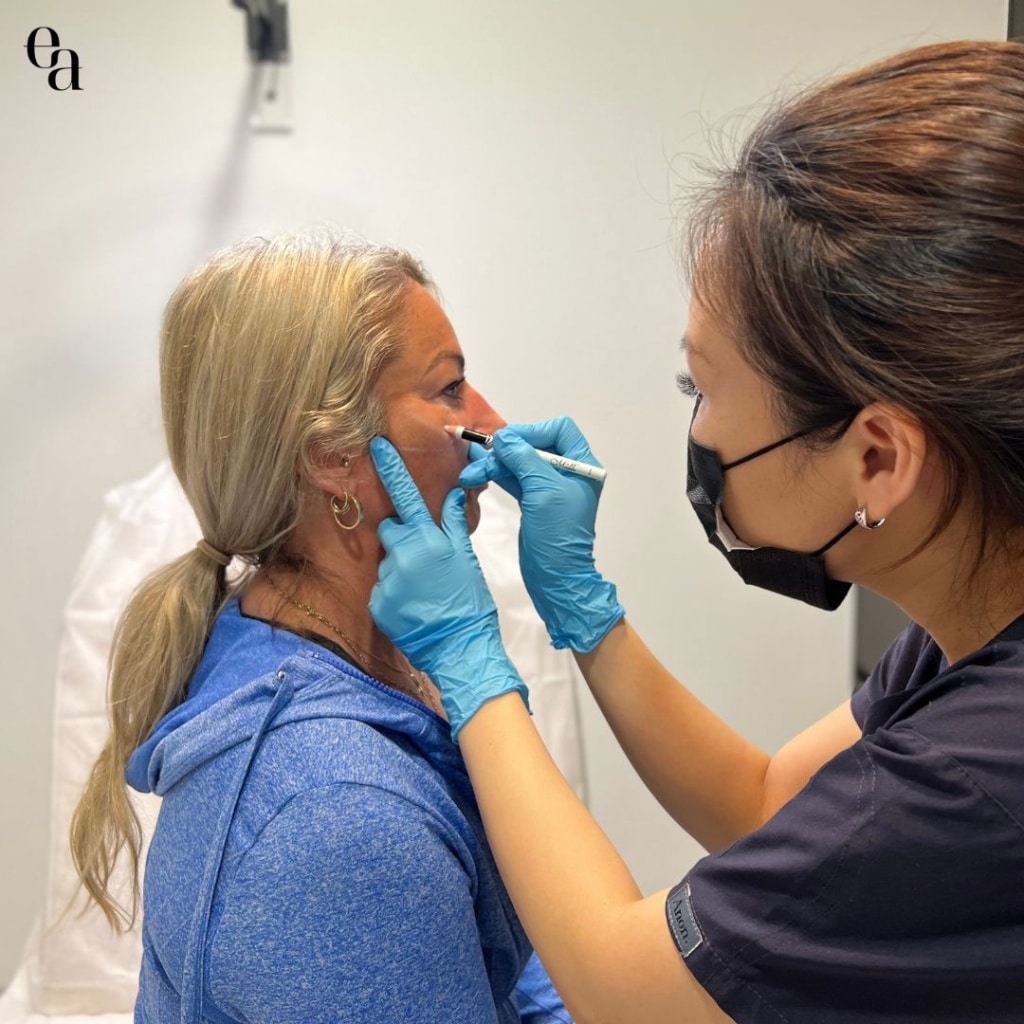The Importance Of Informed Consent In Cosmetic Nursing
- Discover the Benefits Today

Informed consent is a fundamental principle for cosmetic nurses and doctors practising in non-surgical cosmetic procedures in Australia. It forms the foundation of trust and safety, ensuring patients are fully aware of the details of their chosen treatment, including potential risks, complications and realistic outcomes.
The Australian Health Practitioner Regulation Agency (AHPRA) provides comprehensive guidelines outlining the responsibilities of cosmetic nurses, doctors and other medical practitioners. This blog aims to explain the key concepts and significance of informed consent in cosmetic nursing and practices. Please note, this guide is for informational purposes only. For a complete understanding, refer to the full AHPRA guidelines.
What is Informed Consent Including Informed Financial Consent?
Informed consent, encompassing informed financial consent, is a vital component of in non-surgical cosmetic procedures. It ensures patients are fully aware of the details, risks, complications and realistic outcomes of their chosen treatment. AHPRA mandates that the cosmetic practitioner performing the procedure must engage in a thorough consent process with the patient. This involves both verbal discussions and providing written information in plain language, ensuring effective communication.
Key terms to understand include:
- Informed Consent: The process by which a patient voluntarily confirms their willingness to undergo a procedure after being fully informed of the treatment, potential risks, alternatives and outcomes.
- Informed Financial Consent: Understanding all costs associated with the procedure, including product, treatment fees, and necessary follow-up care.
- Comorbidities: Existing medical conditions that may affect the procedure’s outcome or risks.
- Revision: Additional procedures that may be needed if the initial procedure does not achieve the desired outcome or if complications arise.
The Importance of Information Provision in Informed Consent
Providing comprehensive information is crucial in the informed consent process, especially for non-surgical cosmetic procedures. Patients need to understand what the treatment involves, including the type of product and dosage, pain management options, whether it is new or experimental, the range of possible short- and long-term outcomes, and the potential need for further treatments. Discussing the potential risks, complications and recovery time, both general and patient-specific, is essential. A range of information must be also provided to the patient in writing post their treatment:
Details of the Non-Surgical Cosmetic Procedure:
- The procedure type, product information and dosing.
- The cosmetic practitioner performing the procedure and prescriber.
- The cosmetic practitioner’s registration type, qualification, training and experience, and of those of anyone else involved in the treatment.
- Total costs.
Outcomes:
- The range of possible outcomes in the short and long term.
Risks and Complications:
- General risks and possible complications associated with the procedure.
- Patient-specific risks, including the possible impact of any comorbidities the patient has.
- The possibility of the need for revision, or further treatment in the short term or long term.
- The process and contact information in the event of or concern or adverse outcome.
Recovery:
- Recovery times and specific after care requirements. By offering clear, realistic information, cosmetic practitioners help patients form grounded expectations and make well-informed decisions about their healthcare.
Consent for Photographs and Videos
Obtaining consent for photographs and videos is an integral part of the non-surgical cosmetic procedure consent process. Cosmetic practitioners must seek explicit permission before taking any images of the patient during consultations or treatment. Patients must be informed about the purpose of these images, how they will be used, where they will be stored and who will have access.
Importantly, patients have the right to refuse the use of their images for advertising purposes, and this consent must be separate from the informed and financial consent. Additionally, patients can withdraw their consent at any time and the cosmetic practitioner must promptly stop using and delete the images if consent is withdrawn.
Understanding the Consent Process
The consent process for non-surgical cosmetic procedures must be thorough and led by the cosmetic practitioner performing the treatment. This responsibility cannot be delegated to another person. Cosmetic practitioners must ensure that patients fully understand the information provided, taking reasonable steps to facilitate this understanding.
Prior to the procedure, informed consent must be obtained during a thorough consultation. The patient must have sufficient time to consider their decision, and are fully informed, thereby safeguarding their rights and promoting ethical practice in non-surgical cosmetic procedures.
Empowering Patients Through Knowledge
Informed consent transcends being merely a legal requirement; it serves as a means to empower patients. When patients have a clear understanding of what a procedure entails, including potential outcomes and the recovery process, they can be better equipped to make informed decisions about their healthcare. This understanding can contribute to increased satisfaction and more positive experiences.
By comprehensively explaining the procedure, potential side effects and necessary post-treatment care, patients can evaluate the benefits and drawbacks to make a well-informed decision. This knowledge helps them to actively manage their healthcare journey.
Reach Out to Learn More About Our Services
At Esteem Academy, we provide extensive training for cosmetic nurses, including topics such as informed consent. This includes understanding its importance, how to obtain it and ensuring everything is documented correctly. Our approach focuses on transparency, personalised care and continuous education. We encourage you to explore our comprehensive cosmetic nursing courses. For more information, get in touch with us today!
- Discover the Benefits Today

In the dynamic and complex field of aesthetic practices, indemnity insurance plays a significant role for aesthetic practitioners and their patients. It provides protection and reassurance to both parties, helping to ensure any unforeseen incidents or claims are covered. In this blog, we’ll help you understand the comprehensive overview of the importance of indemnity insurance as an aesthetic practitioner.
Understanding Indemnity Insurance: A Must For Aesthetic Practitioners
Indemnity insurance plays a significant role for professionals in the aesthetic industry. It provides a layer of financial protection against claims of negligence or malpractice, aiming to support practitioners in carrying out their duties with confidence and security.
What Is Indemnity Insurance?
Indemnity insurance is designed to protect professionals from bearing the full cost of defending against a negligence claim made by a patient and damages awarded in such a civil lawsuit.
Features of an Indemnity Insurance Policy
When choosing an indemnity insurance policy, there are several key features to consider:
- Coverage Scope: Understand the range of procedures and situations covered.
- Limit of Indemnity: Know the maximum amount the insurance will pay out.
- Exclusions: Be aware of what is not covered by your policy.
Why Do Aesthetic Practitioners Need Indemnity Insurance?
In the realm of aesthetic practice, even with the highest standards of practice, there is always a risk of unforeseen complications or dissatisfied patients. Indemnity insurance is essential as it safeguards practitioners against the financial implications of legal actions, allowing them to focus on providing the best care possible without the looming fear of litigation.
How to Choose the Right Indemnity Insurance for Your Aesthetic Practice?
Selecting the appropriate indemnity insurance requires careful consideration of several factors to ensure comprehensive coverage:
Assess the Level of Risk Associated with Your Services
Understanding the specific risks involved in your aesthetic procedures is the first step in selecting indemnity insurance. This assessment helps in identifying the extent of coverage needed to mitigate these risks effectively.
Compare Policy Terms and Conditions
Carefully reviewing and comparing the terms and conditions of various indemnity insurance policies is essential. This comparison should focus on the scope of coverage, exclusions and the claims process to ensure it meets your practice’s needs.
Check for Flexibility in Coverage
As your aesthetic practice grows and evolves, so too will your insurance needs. It’s important to choose a policy that offers flexibility, allowing you to adjust your coverage as new services are added or as regulatory requirements change.
Legal Implications: Understanding Your Rights and Responsibilities
It’s important for aesthetic practitioners to comprehend their legal standing and obligations when it comes to indemnity insurance.
Understanding Your Policy
Familiarise yourself with the specifics of your policy, including claim reporting procedures and any conditions or warranties.
Navigating Claims
Know the process for handling and reporting claims, as well as your insurer’s role in defending against allegations of malpractice.
Key Coverages of Indemnity Insurance for Professionals
Indemnity insurance typically covers:
- Professional Negligence: Costs from claims of malpractice.
- Legal Defence Costs: Fees for defending against claims.
- Good Samaritan Acts: Liability for emergency care.
- Libel and Slander: Protection against defamation claims.
- Breach of Confidentiality: Costs from unauthorised information release.
- Loss of Documents: Expenses for lost or damaged documents.
- Inquiry Costs: Legal representation at professional inquiries.
Benefits of Indemnity Insurance for Aesthetic Practitioners
Indemnity insurance offers numerous advantages, providing peace of mind and fostering a secure environment for both practitioners and patients.
Financial Protection
Safeguards against potentially crippling legal fees and compensation claims.
Professional Reputation
Helps maintain your professional standing by enabling you to address claims efficiently and effectively.
Patient Trust
Builds patients’ confidence in your services, knowing that you are backed by a comprehensive indemnity insurance policy.
Protect Your Aesthetic Practice With Indemnity Insurance
At Esteem Academy, we understand the significance of indemnity insurance for aesthetic practitioners. That’s why we make sure our students are well-informed about the benefits and requirements of indemnity insurance during their training. We also provide insurance coverage during practical training sessions, ensuring that our students have the necessary protection while learning and honing their skills. To learn more about our training courses and insurance policies, please don’t hesitate to reach out.
Esteem Academy specialises in providing educational and clinical excellence in non-surgical, cosmetic injectable and dermal aesthetic practices. We equip Doctors, Nurses and Beauty Professionals who are wanting to develop or expand their expertise with the highest level of education and hands-on clinical training, so they in return, have the ability to provide aesthetic practices safely, competently and confidently.




